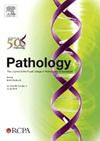Digital image analysis of gland-to-stroma ratio by CD10 objectively differentiates between low-grade endometrioid carcinoma and atypical hyperplasia on endometrial biopsy
IF 3
3区 医学
Q1 PATHOLOGY
引用次数: 0
Abstract
Distinguishing between endometrial atypical hyperplasia/endometrial intraepithelial neoplasia (EAH/EIN) and grade 1 endometrial endometrioid carcinoma (EEC) requires the evaluation of gland-to-stromal ratio, presence of stromal invasion, extent of epithelial proliferation and nuclear alterations. In small biopsies, stromal invasion may not always be sampled, so other features become more important. However, assessing of some of these features may be subjective. Digital analysis improves diagnostic uniformity, and when combined with CD10 immunostain, it can potentially become a useful objective parameter. Endometrial biopsies with a diagnosis of EAH/EIN or EEC matched were retrieved with subsequent hysterectomy for reference diagnosis. CD10 immunohistochemistry was applied to the biopsies, followed by scanning and annotation. Pixel-accurate stromal percentages were deduced from digitised whole-slide images from a test cohort. An optimal stromal percentage cut-off, thus gland-to-stroma ratio, was extrapolated from the receiver operating characteristic curve. A separate cohort was used to validate the diagnostic performance of the determined gland-to-stroma cut-off. Seventy endometrial biopsies were included in the test cohort, comprising 48 grade 1 EECs and 22 EAH/EINs. The mean stromal percentage was 15.69% for EEC and 33.65% for EAH/EIN (all endometrial tissue annotated/analysed) and 14.77% for EEC and 31.88% for EAH/EIN (only lesional tissue annotated/analysed). The corresponding gland-to-stroma ratio was 5:1 for EEC and 2:1 for EAH/EIN. The areas under curve were 0.758 (p=0.001) (all endometrial tissue) and 0.761 (p=0.001) (only lesional tissue), (p=0.001). In the validation cohort, a cut-off of 30% CD10-stained stroma (7:3 gland-to-stroma ratio) was superior in diagnostic performance than the H&E diagnosis (p=0.042). Evaluation of gland-to-stroma ratio using CD10 immunostain and digital image analysis is a robust and objective method for distinguishing between grade 1 EEC and EAH/EIN in small biopsies. A cut-off >7:3 is highly indicative of EEC.
CD10对低级别子宫内膜样癌和子宫内膜非典型增生的诊断价值。
区分子宫内膜不典型增生/子宫内膜上皮内瘤变(EAH/EIN)和1级子宫内膜样癌(EEC)需要评估腺体与基质的比例、基质浸润的存在、上皮增生的程度和核改变。在小型活组织检查中,间质浸润可能并不总是取样,因此其他特征变得更加重要。然而,对其中一些特征的评估可能是主观的。数字分析提高了诊断的一致性,当与CD10免疫染色相结合时,它可能成为一个有用的客观参数。诊断为EAH/EIN或EEC匹配的子宫内膜活检与随后的子宫切除术作为参考诊断。活检采用CD10免疫组化,然后扫描和注释。从测试队列的数字化整张幻灯片图像中推断出像素精确的基质百分比。从受体工作特性曲线中推断出最佳间质百分比截止值,即腺体与间质比率。一个单独的队列被用来验证确定的腺体-基质切断的诊断性能。70例子宫内膜活检纳入试验队列,包括48例1级EECs和22例EAH/EINs。EEC的平均间质百分比为15.69%,EAH/EIN的平均间质百分比为33.65%(所有子宫内膜组织注释/分析),EEC为14.77%,EAH/EIN为31.88%(仅病变组织注释/分析)。EEC对应的腺体与基质比例为5:1,EAH/EIN为2:1。曲线下面积0.758 (p=0.001)(所有子宫内膜组织)和0.761 (p=0.001)(仅病变组织)(p=0.001), (p=0.001)。在验证队列中,30%的cd10染色间质(腺体与间质之比为7:3)在诊断性能上优于H&E诊断(p=0.042)。使用CD10免疫染色和数字图像分析评估腺体与间质比率是区分小活检中1级EEC和EAH/EIN的可靠和客观的方法。临界值为7:3是欧共体的高度指标。
本文章由计算机程序翻译,如有差异,请以英文原文为准。
求助全文
约1分钟内获得全文
求助全文
来源期刊

Pathology
医学-病理学
CiteScore
6.50
自引率
2.20%
发文量
459
审稿时长
54 days
期刊介绍:
Published by Elsevier from 2016
Pathology is the official journal of the Royal College of Pathologists of Australasia (RCPA). It is committed to publishing peer-reviewed, original articles related to the science of pathology in its broadest sense, including anatomical pathology, chemical pathology and biochemistry, cytopathology, experimental pathology, forensic pathology and morbid anatomy, genetics, haematology, immunology and immunopathology, microbiology and molecular pathology.
 求助内容:
求助内容: 应助结果提醒方式:
应助结果提醒方式:


